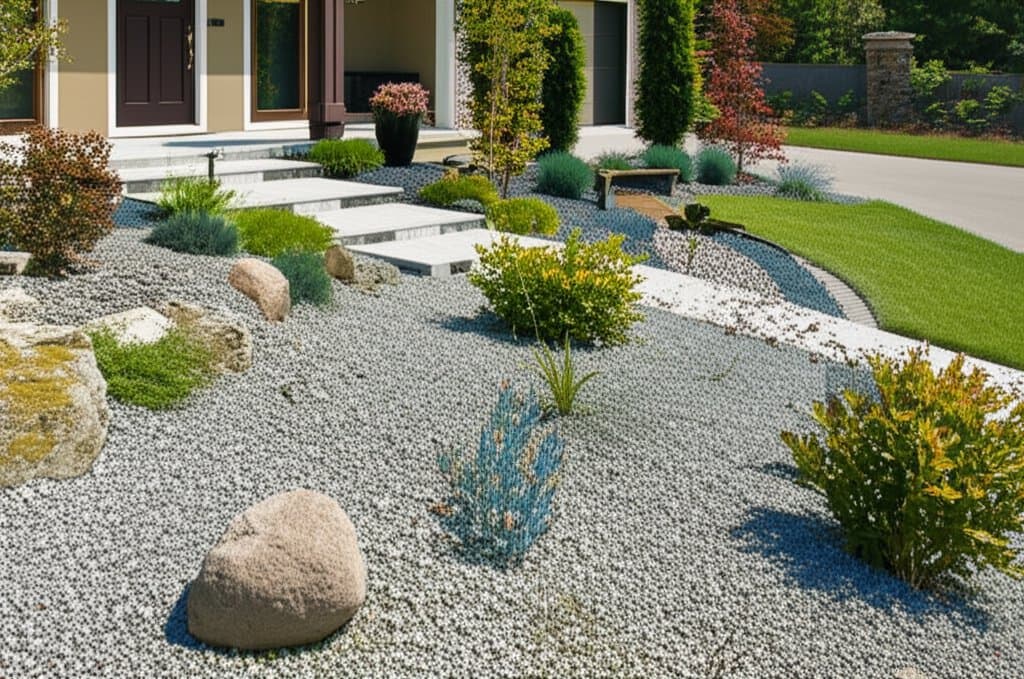Understanding Gravel Gardens
Gravel gardens offer a practical alternative to traditional lawns, especially in regions facing water shortages. They feature permeable surfaces covered with stones and drought-resistant plants, which reduce the need for frequent watering and mowing. This approach aligns with growing environmental awareness, allowing yards to thrive with less effort.
Homeowners benefit from lower costs over time, as gravel setups demand fewer resources than turf. The design supports local ecosystems by providing habitats for pollinators and beneficial insects. With proper execution, these gardens maintain their appeal through seasons without constant intervention.
Benefits of Switching to Gravel
Traditional lawns consume significant water and require ongoing care, including fertilizers and pesticides that can harm the environment. Gravel gardens address these issues by promoting water conservation and natural biodiversity. They filter rainwater into the soil, preventing runoff and aiding groundwater recharge.
Evaluating Your Yard for Conversion
Start by testing soil drainage with a simple percolation check: dig a hole, fill it with water, and observe how quickly it drains. Clay soils may require amendments like sand or organic matter to improve flow. Assess the site's slope to determine if terracing or retaining edges become necessary to hold gravel in place.
Sunlight patterns play a key role; most gravel gardens perform best in full sun, but incorporate shade options like hostas for dimmer areas. Consider your aesthetic preferences, such as a sleek modern look with succulents or a wilder vibe with native wildflowers. These factors guide material choices and layout decisions.
Essential Tools and Materials
Gather a landscape rake, tamper, shovel, and wheelbarrow to handle site preparation and gravel distribution. Install permeable landscape fabric to block weeds while permitting water passage. Select edging like metal or stone to define boundaries and prevent shifting.
Opt for gravel in varied sizes: a fine crushed stone base for stability and larger decorative pebbles for surface appeal. Choose drought-tolerant plants such as lavender, sedum, thyme, and ornamental grasses that match your climate. These elements ensure a durable, visually cohesive garden.
Step-by-Step Installation Guide
Preparing the Site
Clear away existing grass, roots, and debris using a shovel to reach bare soil. Grade the area to direct water away from buildings, creating a slight slope if needed. This foundation prevents future water issues and supports even gravel settling.
Installing the Base
Lay landscape fabric over the prepared soil, securing it with stakes to avoid shifts. Spread a two-inch layer of fine gravel or crushed stone, then compact it firmly with a tamper. This base layer provides stability and drainage essential for longevity.
Adding the Surface Layer
Distribute decorative gravel evenly, aiming for a half-inch to three-quarter-inch depth. Rake it smooth to achieve uniform coverage and texture. Avoid overfilling to maintain permeability and ease of maintenance.
Planting and Finishing
Cut slits in the fabric for plants, digging holes wider than root balls and mixing in native soil with small gravel for backfill. Water deeply to establish roots, then add edging to secure the perimeter. Allow time for settling before heavy use.
Selecting and Planting for Success
Match plants to your yard's conditions; Mediterranean varieties like rosemary and sage thrive in dry, gravelly settings and release pleasant aromas. Ornamental grasses such as blue fescue add height and movement without dominating the space. Space plants to allow growth while covering soil effectively.
After planting, provide initial deep watering to encourage root development. Transition to infrequent sessions during dry periods once established. Integrate lighting elements like solar path lights early to highlight textures without disrupting the gravel.
Ensuring Durability and Health
Monitor the garden in the first year for gravel displacement or pooling water, replenishing thin spots as needed. Manually remove any emerging weeds before they root, relying on the fabric for primary control. Check plant vigor regularly, adjusting care if stress appears from adaptation.
Prune perennials in spring to promote fresh growth, and divide grasses every few years to manage density. Introduce boulders or containers for added interest and to break up monotony. These practices keep the garden vibrant with minimal effort.
Sustaining Your Gravel Garden Over Time
Replenish the top gravel layer every three to five years to refresh appearance and fill gaps. Rake periodically to redistribute stones and avoid compaction from foot traffic. This routine preserves the clean, natural look without intensive labor.
Incorporate seasonal elements like spring bulbs or fall asters for ongoing color. Strategic drip irrigation, buried beneath the surface, delivers water efficiently to plants only. Regular edging checks maintain sharp lines and contain materials effectively.
Realizing the Rewards of a Gravel Garden
A well-crafted gravel garden transforms a standard yard into a resilient, low-demand oasis. It conserves water, supports wildlife, and eliminates mowing drudgery, freeing time for enjoyment. Homeowners discover a sustainable space that evolves beautifully, reflecting thoughtful design and environmental stewardship.




